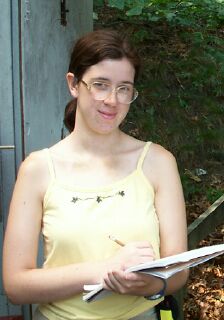|

Report
of Ann Bodio, student technician, fourth week of work, July
2002.
"Today
I (was) introduced to Rick's nephew, Michael, and his sister-in-law,
Carol. Now there (are) quite a few people working here; the
list includes...Alex, Andy, Ann, Amadine, Carol, Debra, Drew,
and Rick. ...Enid and I worked on designing an adhesive that
would work on scallops...We first tested an adhesive that
was for bones/dental: cement #51458. Problem is (there are)
no directions on how much of the mix we need to (combine with
solvent). This adhesive has two parts. The first part is cement
powder pink #115102 and the second part is... #272002. (At)
11:15 cement the scallops to netting, letting them air dry
for 15 minutes. Animals are clapping their shells trying to
escape. (At) 11:30 we put the animals back in the water and
two came off right away. Four are attached. (At) 12:30...another
detached."
(Test of next adhesive) "We would try either compressed air
or alcohol to dry (the shell surface) to see if the adhesive
would work more effectively. Our second trial we did with
PSI-326 and compressed air. PSI kit part A Y3645 and part
B 52798. This is one the cadets found the most effective.
Waited 15 minutes for the epoxy PSI-326, which is also known
as Smart Glue (to set up). Epoxy hard to mix; the leftover
epoxy will be an indicator. Good sign when it gets...warm
it means it is exothermic and is working. (At) 1:09 I put
the scallops in the water. I think this will work the best
out of all the ...adhesives.."
"...I
gave the animals downstairs 8 liters per each sieve of the
RIISO,..which is the darker brown algae, while Drew gave them
8 liters per each sieve of the dark green algae (TCHI)." |

